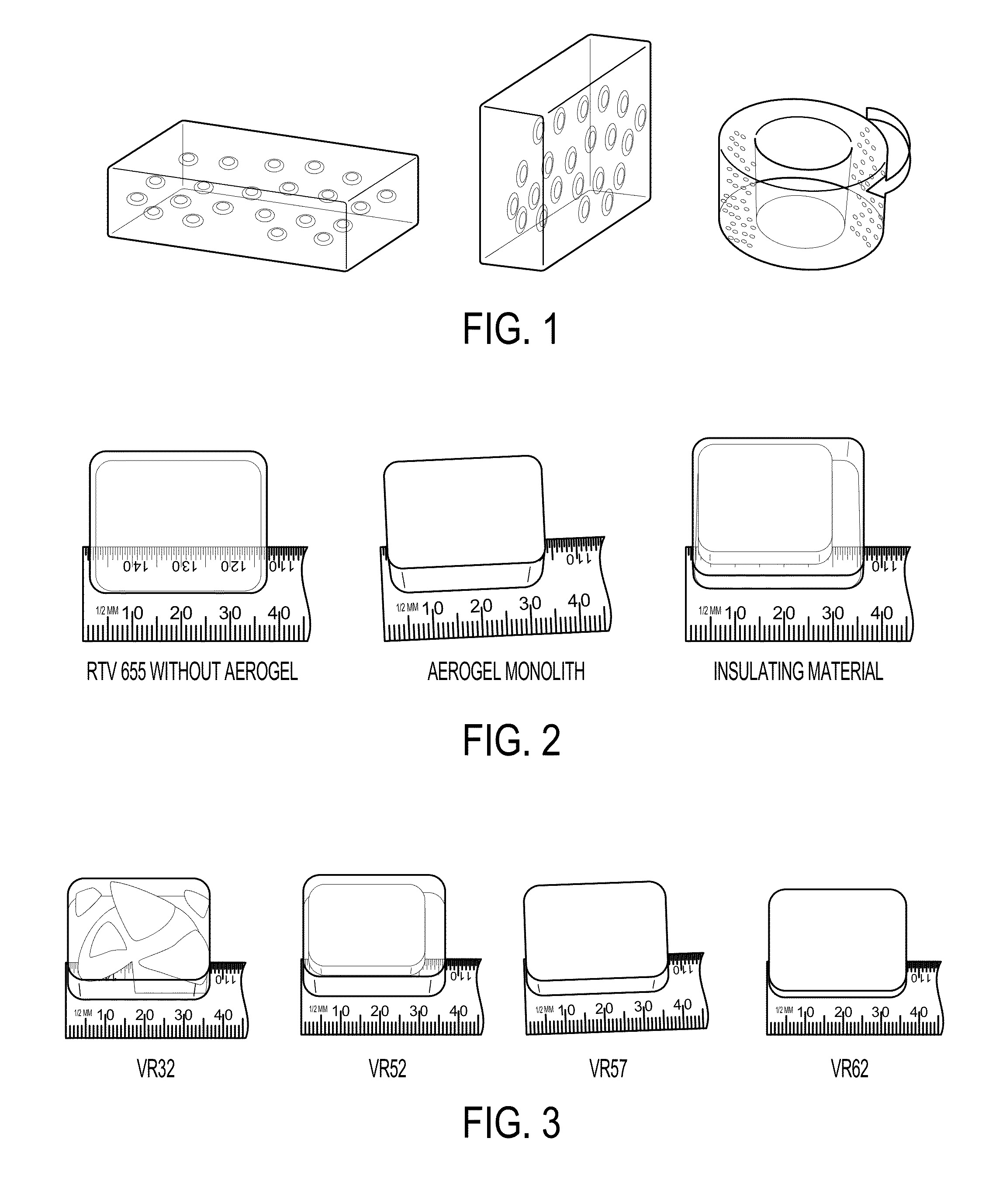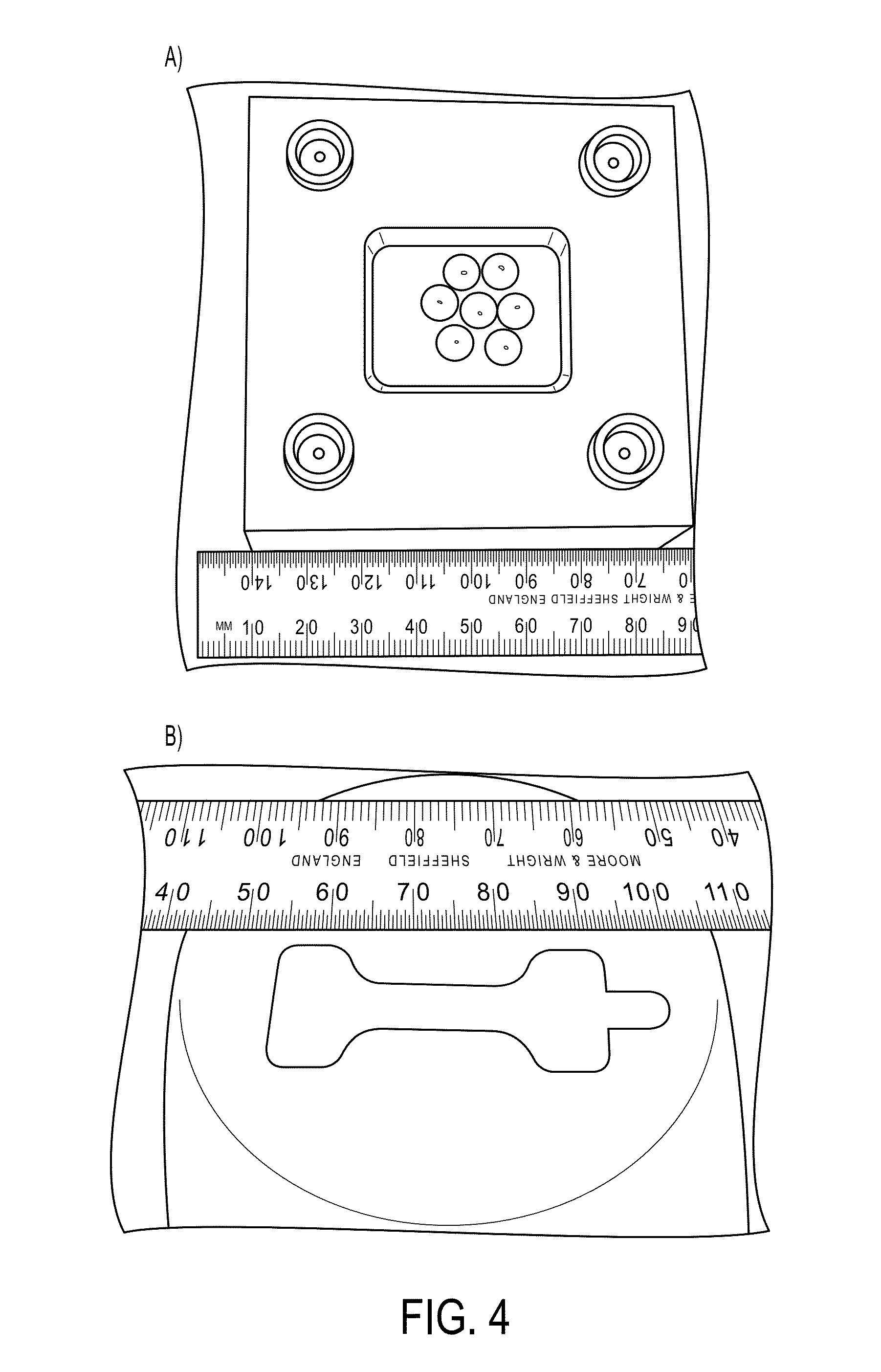Insulating material comprising an elastomer impregnated with aerogel-base
a technology of elastomer and aerogel, which is applied in the direction of heat-proofing, closure using stoppers, liquid handling, etc., can solve the problems of brittleness and micro-cracks, unreliable long-term storage of cryogenic propellants, and severe limitations in insulation design
- Summary
- Abstract
- Description
- Claims
- Application Information
AI Technical Summary
Benefits of technology
Problems solved by technology
Method used
Image
Examples
example 1
Preparation of Aerogels
Materials and Methods
[0106]Preparation of Pigment-Doped Aerogels:
[0107]Two solutions, the first containing 3.85 mL tetramethoxysilane (TMOS), 3-aminopropylsilane and methanol (4.5 mL) and the second one containing methanol (4.5 mL), water (1.5 mL) and a suspension of the metal oxide pigment (4% weight) were cooled in a mixture of dry-ice acetone. The cold solutions were shaken vigorously and were mixed while cold. The resulting sol was immediately poured into molds and gelled within 60 sec while still cold. The gels were aged for 3 hrs then washed once with methanol (once) and four times with acetonitrile using 4-5 times the volume of the gel for each wash. Subsequently, gels were transferred in an isocyanate bath containing 33 g of Desmodur N3200 (Bayer) in 94 mL of acetonitrile. The volume of the bath was again 4-5 times the volume of each gel. After 24 hrs, the gels were transferred in fresh acetonitrile and they were heated at 70° C. for 72 hrs. At the end...
example 2
Preparation of Aerogel Substrates
[0108]Making of Aerogel Substrates:
[0109]Two solutions, the first containing 3.85 mL tetramethoxysilane (TMOS), 3-aminopropylsilane and methanol (4.5 mL) and the second one containing methanol (4.5 mL), water (1.5 mL) and a suspension of the metal oxide pigment (4% weight) were cooled in a mixture of dry-ice acetone. The cold solution was shaken vigorously and was mixed while cold. The resulting solution was immediately poured into molds and gelled within 60 seconds while still cold.
[0110]The gels were aged for 3 hours and subsequently washed once with methanol and four times with acetonitrile using 4-5 times the volume of the gel for each wash. Subsequently, gels were transferred in an isocyanate bath containing 33 g of Desmodur N3200 (Bayer) in 94 mL of acetonitrile. The volume of the bath was again 4-5 times the volume of each gel.
[0111]After 24 hours, the gels were transferred in fresh acetonitrile and they were heated at 70° C. for 72 hours. At ...
example 3
Preparation of Aerogel-Silicone Polymer Materials
[0112]Prototype Mold Design
[0113]Molds for the aerogel samples and building molds for curing the silicone polymer are prepared from teflon, stainless steel, aluminium, or ultra high molecular weight polyethylene (UHMWPE) using standard machine molding techniques. The molds are tested for tolerance to the chemicals used during the synthesis stage.
[0114]Synthesis
[0115]Aerogel:
[0116]Vanadium crosslinked and polyurea crosslinked silica aerogels are synthesized using one of two methods:
[0117]1) evaporative technique as described in reference [2]; and
[0118]2) critical point drying (CPD) in a liquid CO2 environment.
[0119]The thermal insulation quality of the aerogels are measured and compared with Aspen Aerogel blankets reported values. A tensile (compression) tester monitors the mechanical properties of each synthesized batch.
[0121]Silicone polymer sheets are synthesized and layered with uniform thickness aerogel disc...
PUM
| Property | Measurement | Unit |
|---|---|---|
| temperatures | aaaaa | aaaaa |
| temperatures | aaaaa | aaaaa |
| temperatures | aaaaa | aaaaa |
Abstract
Description
Claims
Application Information
 Login to View More
Login to View More - R&D
- Intellectual Property
- Life Sciences
- Materials
- Tech Scout
- Unparalleled Data Quality
- Higher Quality Content
- 60% Fewer Hallucinations
Browse by: Latest US Patents, China's latest patents, Technical Efficacy Thesaurus, Application Domain, Technology Topic, Popular Technical Reports.
© 2025 PatSnap. All rights reserved.Legal|Privacy policy|Modern Slavery Act Transparency Statement|Sitemap|About US| Contact US: help@patsnap.com



